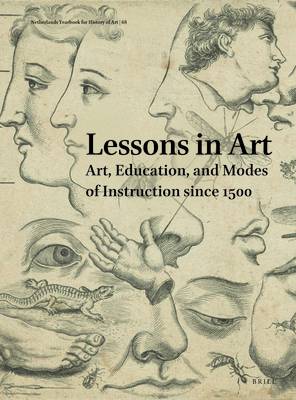
- Afhalen na 1 uur in een winkel met voorraad
- Gratis thuislevering in België vanaf € 30
- Ruim aanbod met 7 miljoen producten
- Afhalen na 1 uur in een winkel met voorraad
- Gratis thuislevering in België vanaf € 30
- Ruim aanbod met 7 miljoen producten
Zoeken
Netherlands Yearbook for History of Art / Nederlands Kunsthistorisch Jaarboek 68 (2018)
Lessons in Art. Art, Education, and Modes of Instruction Since 1500
€ 264,45
+ 528 punten
Omschrijving
Why, how, to whom, and by whom was art taught? Lessons in Art (Netherlands Yearbook for History of Art, Vol 68) provides answers to these questions by addressing the relation between art and education in the Netherlands from 1500 to the 1970s. The authors gathered in this volume consider the practical and theoretical education of artists as well as the role of art and creativity for general education within a wide societal context. They present new ways of looking at teaching materials and methods, that were devised for the education of experts, and show how art and creativity were employed as powerful didactic tools for a general audience. From early-modernity to the present, education, it appears, fuels the production and perception of art.
Table of Contents
1.Ann-Sophie Lehmann & Bart Ramakers, Introduction
2.Caecilie Weissert, Clément Perret's Exercitatio alphabetica (1569). A calligraphic textbook and sample book on eloquence
3.Koen Jonckheere, Aertsen, Rubens and the questye in early modern painting
4.Edward H. Wouk, From Lambert Lombard to Aby Warburg. Pathosformel as grammar
5.Bart Ramakers, Paper, paint, and metal foil. How to costume a tyrant in late sixteenth century Holland
6.Ann-Sophie Lehmann, An alphabet of colours. Valcooch's Rules and the emergence of sense-based learning around 1600
7.Jenny Boulboullé, Drawn up by a learned physician from the mouths of artisans. The Mayerne manuscript revisited
8.Erin Travers, Jacob van der Gracht's Anatomie for artists
9.Jaya Remond, 'Draw everything that exists in the world'. 't Light der Teken en Schilderkonst and the shaping of art education in early modern northern Europe
10.Joost Keizer, Rembrandt's nature. The ethics of teaching style in the Dutch Republic
11.Erin Downey, Learning in Netherlandish workshops in seventeenth-century Rome
12.Annemarie Kok, Do it yourself! Lessons in participation in a dynamic labyrinth in the Stedelijk Museum Amsterdam
Table of Contents
1.Ann-Sophie Lehmann & Bart Ramakers, Introduction
2.Caecilie Weissert, Clément Perret's Exercitatio alphabetica (1569). A calligraphic textbook and sample book on eloquence
3.Koen Jonckheere, Aertsen, Rubens and the questye in early modern painting
4.Edward H. Wouk, From Lambert Lombard to Aby Warburg. Pathosformel as grammar
5.Bart Ramakers, Paper, paint, and metal foil. How to costume a tyrant in late sixteenth century Holland
6.Ann-Sophie Lehmann, An alphabet of colours. Valcooch's Rules and the emergence of sense-based learning around 1600
7.Jenny Boulboullé, Drawn up by a learned physician from the mouths of artisans. The Mayerne manuscript revisited
8.Erin Travers, Jacob van der Gracht's Anatomie for artists
9.Jaya Remond, 'Draw everything that exists in the world'. 't Light der Teken en Schilderkonst and the shaping of art education in early modern northern Europe
10.Joost Keizer, Rembrandt's nature. The ethics of teaching style in the Dutch Republic
11.Erin Downey, Learning in Netherlandish workshops in seventeenth-century Rome
12.Annemarie Kok, Do it yourself! Lessons in participation in a dynamic labyrinth in the Stedelijk Museum Amsterdam
Specificaties
Betrokkenen
- Uitgeverij:
Inhoud
- Aantal bladzijden:
- 408
- Taal:
- Engels
- Reeks:
- Reeksnummer:
- nr. 68
Eigenschappen
- Productcode (EAN):
- 9789004396739
- Verschijningsdatum:
- 26/09/2019
- Uitvoering:
- Hardcover
- Formaat:
- Genaaid
- Afmetingen:
- 206 mm x 264 mm
- Gewicht:
- 1542 g

Alleen bij Standaard Boekhandel
+ 528 punten op je klantenkaart van Standaard Boekhandel
Beoordelingen
We publiceren alleen reviews die voldoen aan de voorwaarden voor reviews. Bekijk onze voorwaarden voor reviews.










